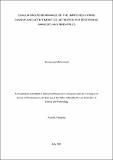| dc.description.abstract | Farmers in East Africa have no access to modern processing technologies because they are
costly and high-energy demanding to operate. As a result, they solely rely on the traditional
open sun drying (OSD) method, which is ineffective and causes further loss of the produce.
In response, a modified passive-mode hybrid solar dryer dubbed ‘Improved Solar Dryer
(ISD)’ unit was developed. A conventional active mode hybrid solar dryer nicknamed a
‘Solar Photovoltaic and Electric (SPE)’ dryer was fabricated. In this study, the drying
performance of the individual ISD and SPE dryers was evaluated and compared against that
of the OSD method. The effect of the individual ISD and SPE dryers on the nutritional
content and sensory quality of the solar-dried fruits, namely mangoes and pineapples, was
also assessed. The fruits were dried using the ISD and SPE dryers, and OSD methods while
following randomized complete block design experimental procedures. Results show that the
drying performance of the ISD and SPE dryers was better than that of the OSD method. The
SPE and ISD dryers took 10 and 18 hours to effectively dry the fruit products, respectively,
as opposed to the 30 hours taken by the OSD method. The mean daily ambient temperature
and relative humidity were 26.8oC and 26.7%, respectively. The mean drying air
temperatures achieved by the ISD and SPE dryers were 27.7 and 40.3oC, respectively. The
mean relative humidity achieved by the ISD and SPE dryers during the entire food drying
process were 25.8 and 24.6%, respectively. The mean solar thermal energy recorded for the
ISD dryer, SPE dryer, and OSD method were 4795, 5994, and 3595 W/m2
(Watts per square
meter), respectively. The results suggest that the SPE dryer exhibited better drying
performance than the ISD dryer. The results also confirm that the drying conditions attained
by both the SPE and ISD dryers were superior to that of the OSD method. Results confirm an
enhanced capacity and superior role of the ISD and SPE dryers in retaining both the sensory
quality and nutritional content. Therefore, the ISD and SPE dryers are recommended for
drying fruits. | en_US |

